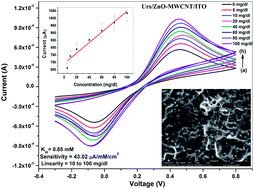Zinc oxide–multiwalled carbon nanotubes hybrid nanocomposite based urea biosensor†
Abstract
An efficient matrix comprising a hybrid nanocomposite of zinc oxide (ZnO) and multiwalled carbon nanotubes (MWCNTs) has been synthesised on indium tin oxide coated glass slides (ITO/Glass) using a chemical route deposition technique for the realization of an efficient urea biosensor. Urease (Urs) was used as the specific enzyme for urea detection and was physically immobilized over the surface of the hybrid nanocomposite matrix based (ZnO–MWCNT/ITO) electrode. The fabricated Urs/ZnO–MWCNT/ITO bioelectrode was characterized using electrochemical impedance spectroscopy (EIS) and cyclic voltammetric (CV) techniques. The nanocomposite based bioelectrode i.e. Urs/ZnO–MWCNT/ITO exhibits enhanced biosensing response characteristics as compared to that of the bare ZnO based (Urs/ZnO/ITO) bioelectrode. The prepared bioelectrode (Urs/ZnO–MWCNT/ITO) exhibits a very high sensitivity of about 43.02 μA mM−1 cm−2 and a long shelf-life of more than 4 months (>16 weeks). The low Michaelis–Menten parameter (Km) value, only 0.85 mM, indicates high affinity of the immobilized urease on the surface of hybrid nanocomposite matrix towards its analyte (urea). The obtained results in the present study are encouraging and will pave the way towards the realization of an efficient urea biosensor.


 Please wait while we load your content...
Please wait while we load your content...